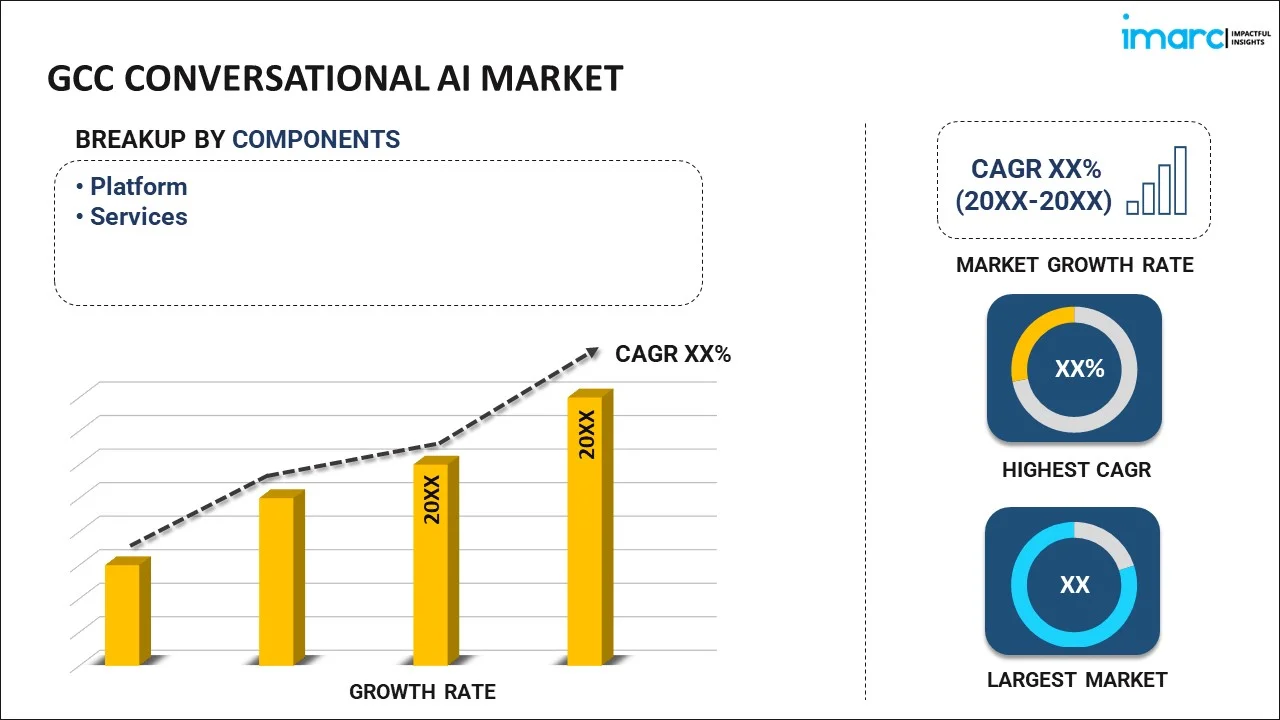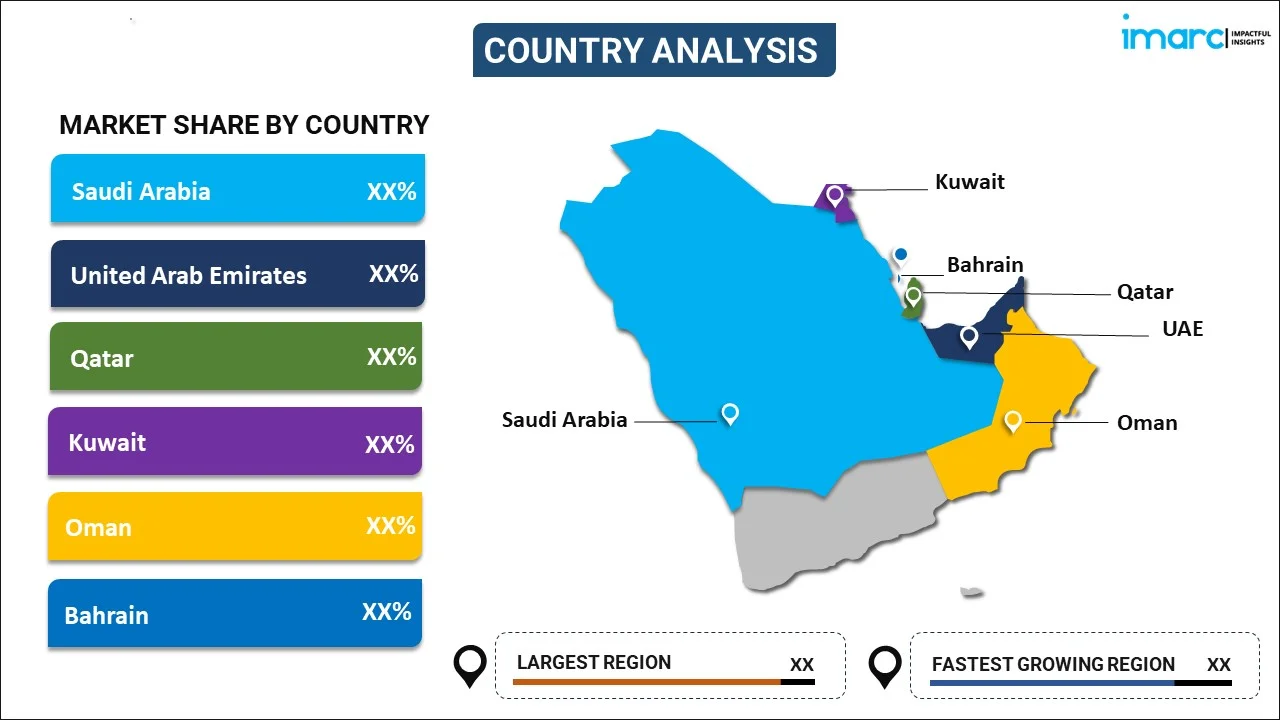
GCC Conversational AI Market Report by Component (Platform, Services), Deployment (Cloud-Based, On-Premises), Type (Intelligent Virtual Assistant (IVAs), Chatbots), End User (BFSI, Retail and E-Commerce, Healthcare, IT & Telecom, Media and Entertainment, and Others), and Country 2025-2033
Market Overview:
The GCC conversational AI market size reached USD 324.6 Million in 2024. Looking forward, IMARC Group expects the market to reach USD 2,185.5 Million by 2033, exhibiting a growth rate (CAGR) of 23.6% during 2025-2033. The heightened emphasis on customer experience, the booming e-commerce sector, expanding digitalization, favorable government initiatives, and sector-specific optimization across industries represent some of the key factors driving the market.
|
Report Attribute
|
Key Statistics
|
|---|---|
|
Base Year
|
2024 |
|
Forecast Years
|
2025-2033
|
|
Historical Years
|
2019-2024
|
| Market Size in 2024 | USD 324.6 Million |
| Market Forecast in 2033 | USD 2,185.5 Million |
| Market Growth Rate (2025-2033) | 23.6% |
Conversational AI refers to an advanced technology that enables natural and dynamic interactions between humans and computers. It utilizes various techniques from natural language processing (NLP), machine learning, and artificial intelligence to create virtual agents, chatbots, or voice assistants that can engage in human-like conversations. These systems are designed to understand and interpret human language in written and spoken forms, and they respond in a manner that simulates genuine conversation. Conversational AI finds numerous applications ranging from customer support and e-commerce to healthcare and education. Organizations use conversational AI to provide instant and personalized assistance to users, enhancing user experiences and reducing response times. This technology continually learns from each interaction, adapting its responses and improving its understanding of context over time. In addition to this, continuous advancements in NLP and machine learning (ML) have fueled the rapid evolution of conversational AI, allowing for more accurate language comprehension, better context recognition, and increased language diversity support. As a result, businesses can leverage conversational AI to automate routine tasks, gather valuable customer insights, and foster more efficient and engaging interactions.
GCC Conversational AI Market Trends:
With a rising number of businesses in the GCC region increasingly prioritizing customer experience, there is an expanding adoption of conversational AI for delivering personalized and prompt interactions, fostering higher satisfaction and loyalty. Besides this, the widespread digitalization and soaring smartphone penetration rates within the GCC region are contributing to the market's growth, as consumers seek frictionless and on-demand services facilitated by conversational AI interfaces. Moreover, the burgeoning e-commerce industry is fueling the employment of conversational AI chatbots to seamlessly guide customers through their purchasing journey and enrich the digital shopping experience. Additionally, the surging product utilization across various industries to streamline internal operations, optimize workflows, and augment employee communication, thus driving operational efficiencies, is creating a positive outlook for market expansion. In confluence with this, the increasing integration of conversational AI in the healthcare setting to expedite appointment scheduling, facilitate remote patient monitoring, and redefine medical consultations is impelling the market growth. Furthermore, surging product employment across financial services to provide virtual banking assistants, automated transactions, and personalized financial advice is presenting remunerative market opportunities. Apart from this, conversational AI's proficiency in numerous languages catering to the linguistic diversity inherent to the region's multicultural landscape and the introduction of various government-led initiatives aimed at technology-driven innovation are strengthening the market growth.
GCC Conversational AI Market Segmentation:
IMARC Group provides an analysis of the key trends in each segment of the GCC conversational AI market report, along with forecasts at the regional and country levels for 2025-2033. Our report has categorized the market based on component, deployment, type, and end user.
Component Insights:

- Platform
- Services
The report has provided a detailed breakup and analysis of the market based on the component. This includes platform and services.
Deployment Insights:
- Cloud-Based
- On-Premises
A detailed breakup and analysis of the market based on the deployment has also been provided in the report. This includes cloud-based and on-premises.
Type Insights:
- Intelligent Virtual Assistant (IVAs)
- Chatbots
The report has provided a detailed breakup and analysis of the market based on the type. This includes intelligent virtual assistant (IVAs) and chatbots.
End User Insights:
- BFSI
- Retail and E-Commerce
- Healthcare
- IT & Telecom
- Media and Entertainment
- Others
A detailed breakup and analysis of the market based on the end user has also been provided in the report. This includes BFSI, retail and e-commerce, healthcare, IT & telecom, media and entertainment, and others.
Country Insights:

- Saudi Arabia
- UAE
- Qatar
- Oman
- Kuwait
- Bahrain
The report has also provided a comprehensive analysis of all the major regional markets, which include Saudi Arabia, UAE, Qatar, Oman, Kuwait, and Bahrain.
Competitive Landscape:
The report has also provided a comprehensive analysis of the competitive landscape in the market. Competitive analysis such as market structure, key player positioning, top winning strategies, competitive dashboard, and company evaluation quadrant has been covered in the report. Also, detailed profiles of all major companies have been provided.
GCC Conversational AI Market Report Coverage:
| Report Features | Details |
|---|---|
| Base Year of the Analysis | 2024 |
| Historical Period | 2019-2024 |
| Forecast Period | 2025-2033 |
| Units | Million USD |
| Scope of the Report | Exploration of Historical and Forecast Trends, Industry Catalysts and Challenges, Segment-Wise Historical and Predictive Market Assessment:
|
| Components Covered | Platform, Services |
| Deployments Covered | Cloud-Based, On-Premises |
| Types Covered | Intelligent Virtual Assistant (IVAs), Chatbots |
| End Users Covered | BFSI, Retail and E-Commerce, Healthcare, IT & Telecom, Media and Entertainment, Other |
| Countries Covered | Saudi Arabia, UAE, Qatar, Bahrain, Kuwait, Oman |
| Customization Scope | 10% Free Customization |
| Post-Sale Analyst Support | 10-12 Weeks |
| Delivery Format | PDF and Excel through Email |
Key Questions Answered in This Report:
- How has the GCC conversational AI market performed so far and how will it perform in the coming years?
- What has been the impact of COVID-19 on the GCC conversational AI market?
- What is the breakup of the GCC conversational AI market on the basis of component?
- What is the breakup of the GCC conversational AI market on the basis of deployment?
- What is the breakup of the GCC conversational AI market on the basis of type?
- What is the breakup of the GCC conversational AI market on the basis of end user?
- What are the various stages in the value chain of the GCC conversational AI market?
- What are the key driving factors and challenges in the GCC conversational AI market?
- What is the structure of the GCC conversational AI market and who are the key players?
- What is the degree of competition in the GCC conversational AI market?
Key Benefits for Stakeholders:
- IMARC’s report offers a comprehensive quantitative analysis of various market segments, historical and current market trends, market forecasts, and dynamics of the GCC conversational AI market from 2019-2033.
- The research study provides the latest information on the market drivers, challenges, and opportunities in the GCC conversational AI market.
- Porter's five forces analysis assist stakeholders in assessing the impact of new entrants, competitive rivalry, supplier power, buyer power, and the threat of substitution. It helps stakeholders to analyze the level of competition within the GCC conversational AI industry and its attractiveness.
- Competitive landscape allows stakeholders to understand their competitive environment and provides an insight into the current positions of key players in the market.
Need more help?
- Speak to our experienced analysts for insights on the current market scenarios.
- Include additional segments and countries to customize the report as per your requirement.
- Gain an unparalleled competitive advantage in your domain by understanding how to utilize the report and positively impacting your operations and revenue.
- For further assistance, please connect with our analysts.
 Inquire Before Buying
Inquire Before Buying
 Speak to an Analyst
Speak to an Analyst
 Request Brochure
Request Brochure
 Request Customization
Request Customization




.webp)




.webp)












